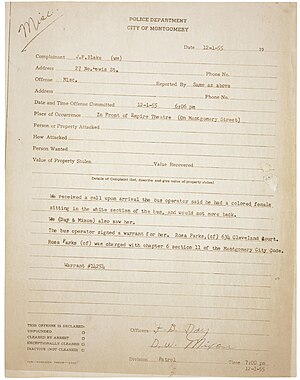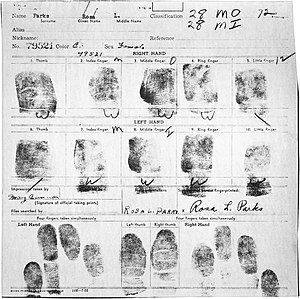Montgomery buses: law and prevailing customs
In 1900, Montgomery had passed a city ordinance (essentially only whites could vote) to segregate bus passengers by race. Conductors were empowered to assign seats to achieve that goal. According to the law, no passenger would be required to move or give up his seat and stand if the bus was crowded and no other seats were available. Over time and by custom, however, Montgomery bus drivers adopted the practice of requiring black riders to move when there were no white-only seats left.The first four rows of seats on each Montgomery bus were reserved for whites. Buses had "colored" sections for black people generally in the rear of the bus, although blacks comprised more than 75% of the ridership. The sections were not fixed but were determined by placement of a movable sign. Black people could sit in the middle rows until the white section filled; if more whites needed seats, blacks were to move to seats in the rear, stand, or, if there was no room, leave the bus. Black people could not sit across the aisle in the same row as white people. The driver could move the "colored" section sign, or remove it altogether. If white people were already sitting in the front, black people had to board at the front to pay the fare, then disembark and reenter through the rear door.
For years, the black community had complained that the situation was unfair. Parks said, "My resisting being mistreated on the bus did not begin with that particular arrest...I did a lot of walking in Montgomery."[4]
One day in 1943, Parks boarded the bus and paid the fare. She then moved to her seat but driver James F. Blake told her to follow city rules and enter the bus again from the back door. Parks exited the bus, but before she could re-board at the rear door, Blake drove off, leaving her to walk home in the rain.[12]
Her refusal to move
After working all day, Parks boarded the Cleveland Avenue bus around 6 p.m., Thursday, December 1, 1955, in downtown Montgomery. She paid her fare and sat in an empty seat in the first row of back seats reserved for blacks in the "colored" section. Near the middle of the bus, her row was directly behind the ten seats reserved for white passengers. Initially, she did not notice that the bus driver was the same man, James F. Blake, who had left her in the rain in 1943. As the bus traveled along its regular route, all of the white-only seats in the bus filled up. The bus reached the third stop in front of the Empire Theater, and several white passengers boarded.
The No. 2857 bus on which Parks was riding before her arrest (a GM "old-look" transit bus, serial number 1132), is now a museum exhibit at the Henry Ford Museum.
By Parks' account, Blake said, "Y'all better make it light on yourselves and let me have those seats."[14] Three of them complied. Parks said, "The driver wanted us to stand up, the four of us. We didn't move at the beginning, but he says, 'Let me have these seats.' And the other three people moved, but I didn't."[15] The black man sitting next to her gave up his seat.[16]
Parks moved, but toward the window seat; she did not get up to move to the redesignated colored section.[16] Blake said,
"Why don't you stand up?" Parks responded, "I don't think I should have to stand up." Blake called the police to arrest Parks. When recalling the incident for Eyes on the Prize, a 1987 public television series on the Civil Rights Movement, Parks said, "When he saw me still sitting, he asked if I was going to stand up, and I said, 'No, I'm not.' And he said, 'Well, if you don't stand up, I'm going to have to call the police and have you arrested.' I said, 'You may do that.'"[17]
Rosa Parks' arrest
Fingerprint card of Parks
In her autobiography, My Story she said:
When Parks refused to give up her seat, a police officer arrested her. As the officer took her away, she recalled that she asked, "Why do you push us around?" She remembered him saying, "I don't know, but the law's the law, and you're under arrest."[20] She later said, "I only knew that, as I was being arrested, that it was the very last time that I would ever ride in humiliation of this kind..."[15]People always say that I didn't give up my seat because I was tired, but that isn't true. I was not tired physically, or no more tired than I usually was at the end of a working day. I was not old, although some people have an image of me as being old then. I was forty-two. No, the only tired I was, was tired of giving in.[19]
Parks was charged with a violation of Chapter 6, Section 11 segregation law of the Montgomery City code,[21] although technically she had not taken a white-only seat; she had been in a colored section.[22] Edgar Nixon, president of the Montgomery chapter of the NAACP and leader of the Pullman Union, and her friend Clifford Durr bailed Parks out of jail the next evening.[23]
Montgomery Bus Boycott
Nixon conferred with Jo Ann Robinson, an Alabama State College professor and member of the Women's Political Council (WPC), about the Parks' case. Robinson believed it important to seize the opportunity and stayed up all night mimeographing over 35,000 handbills announcing a bus boycott. The Women's Political Council was the first group to officially endorse the boycott.On Sunday, December 4, 1955, plans for the Montgomery Bus Boycott were announced at black churches in the area, and a front-page article in The Montgomery Advertiser helped spread the word. At a church rally that night, those attending agreed unanimously to continue the boycott until they were treated with the level of courtesy they expected, until black drivers were hired, and until seating in the middle of the bus was handled on a first-come basis.
Four days later, Parks was tried on charges of disorderly conduct and violating a local ordinance. The trial lasted 30 minutes. After being found guilty and fined $10, plus $4 in court costs,[15] Parks appealed her conviction and formally challenged the legality of racial segregation. In a 1992 interview with National Public Radio's Lynn Neary, Parks recalled:
On the day of Parks' trial — December 5, 1955 — the WPC distributed the 35,000 leaflets. The handbill read,I did not want to be mistreated, I did not want to be deprived of a seat that I had paid for. It was just time... there was opportunity for me to take a stand to express the way I felt about being treated in that manner. I had not planned to get arrested. I had plenty to do without having to end up in jail. But when I had to face that decision, I didn't hesitate to do so because I felt that we had endured that too long. The more we gave in, the more we complied with that kind of treatment, the more oppressive it became.[14]
"We are...asking every Negro to stay off the buses Monday in protest of the arrest and trial ... You can afford to stay out of school for one day. If you work, take a cab, or walk. But please, children and grown-ups, don't ride the bus at all on Monday. Please stay off the buses Monday."[24]It rained that day, but the black community persevered in their boycott. Some rode in carpools, while others traveled in black-operated cabs that charged the same fare as the bus, 10 cents. Most of the remainder of the 40,000 black commuters walked, some as far as 20 miles (30 km).
That evening after the success of the one-day boycott, a group of 16 to 18 people gathered at the Mt. Zion AME Zion Church to discuss boycott strategies. The group agreed that a new organization was needed to lead the boycott effort if it were to continue. Rev. Ralph David Abernathy suggested the name "Montgomery Improvement Association" (MIA).[25] The name was adopted, and the MIA was formed. Its members elected as their president Dr. Martin Luther King, Jr, a relative newcomer to Montgomery, who was a young and mostly unknown minister of the Dexter Avenue Baptist Church.[26]
That Monday night, 50 leaders of the African-American community gathered to discuss actions to respond to Parks' arrest. Edgar Nixon, the president of the NAACP, said, "My God, look what segregation has put in my hands!"[27] Parks was the ideal plaintiff for a test case against city and state segregation laws, as she was a responsible, mature woman with an excellent reputation. King said that Mrs. Parks was regarded as "one of the finest citizens of Montgomery—not one of the finest Negro citizens, but one of the finest citizens of Montgomery."[4] Parks was securely married and employed, possessed a quiet and dignified demeanor, and was politically savvy.
In the end, black residents of Montgomery continued the boycott for 381 days, at considerable personal sacrifice. Dozens of public buses stood idle for months, severely damaging the bus transit company's finances, until the city repealed its law requiring segregation on public buses following the US Supreme Court ruling that it was unconstitutional.
Parks played an important part in raising international awareness of the plight of African Americans and the civil rights struggle. King wrote in his 1958 book Stride Toward Freedom that Parks' arrest was the catalyst rather than the cause of the protest: "The cause lay deep in the record of similar injustices."[28] He wrote, "Actually, no one can understand the action of Mrs. Parks unless he realizes that eventually the cup of endurance runs over, and the human personality cries out, 'I can take it no longer.'
SOURCE: WikiPedia






No comments:
Post a Comment
For now, we're opening this blog to Anonymous comments. This will continue as long as civility rules. Disagree as you may, just keep it clean and stay on topic. No profanity, and no name calling. We reserve the right to moderate such comments, though the person who made it may come back and reword their message in a more civil way.